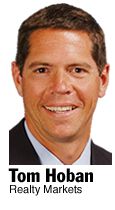 |
|
|
YOUR
COUNTY.
|
YOUR
BUSINESS JOURNAL.
|
Published February 2004
No-growth platform endangers housing, jobs
 Measured
just in terms of calls or e-mails, nothing I’ve written about seems to
stir readers of this column like the growth debate. It makes sense, too.
It’s a subject that affects us all. And it can sometimes be an emotional
debate, pitting the so-called “enviro terrorists” on one side and the
“greedy developers” on the other.
Measured
just in terms of calls or e-mails, nothing I’ve written about seems to
stir readers of this column like the growth debate. It makes sense, too.
It’s a subject that affects us all. And it can sometimes be an emotional
debate, pitting the so-called “enviro terrorists” on one side and the
“greedy developers” on the other.
Traffic, radio antennas, farming, utilities, salmon habitat, access to waterfront, the airport, you name it. Your position on any of these issues is centered on your core feelings about growth.
At a December City Council meeting in Arlington, the council was deciding whether to annex a portion of property at the intersection of I-5 and the Arlington freeway exit.
There are restaurants and gas stations there — just what you’d expect at a major interchange. But there are open spaces and farms there, too. It’s also where Dwayne Lane wanted to move his Arlington auto/truck dealership, currently located in downtown Arlington.
The debate, as we all know from the stories in The Herald, centered on the conversion of land that was designated for farmland use as a means to accomplish the dealership’s move to a more viable location along I-5.
The issue became the poster child of the growth debate in Snohomish County throughout 2003, eventually concluding at the Arlington City Council meeting, when the council voted to allow for annexation of this property into the city and, as a consequence, a conversion of the land’s use the auto dealer had sought all along.
Throughout the debate — most of which occurred in the public eye — there were people on both sides of the aisle. Congressmen, the county executive and many others at the highest levels chimed in. But it was a local Arlington city councilman who described the situation in perhaps the best way.
For him, it was a much more practical issue. He noted that Arlington had grown from a little town of 5,000 to over 15,000 in about a decade and said that if the citizens wanted more schools, roads and utilities, Dwayne Lane’s Auto generated sales-tax revenue sorely needed to do this.
Without Dwayne Lane, “we don’t have the means,” he put it coldly. Arlington simply had to have the dealership’s annual sales-tax revenue in order to take care of some core needs. Moments later, the annexation vote passed.
Throughout the process, Dwayne Lane was castigated for simply trying to sell more cars and stay in Arlington. Those who don’t know Lane and his family would be ashamed if they assumed he and the current generation who run the business were anything short of honorable. His company is the epitome of a responsible business led by balanced people.
So this wasn’t some greedy developer trying to pave over a farm. Just a businessman trying to support his business better and, as a community-minded fellow, keep those jobs and that business in Arlington. There are other exits along I-5 with similar exposure, after all.
Perhaps to stimulate support for their anti-annexation position, the no-growth movement presented the debate as somehow pitting the farmer against the image of the Rodney Dangerfield character in the ’70s golf-comedy movie “Caddyshack,” complete with the yellow slacks and wads of cash spent at every turn. Never mind that the property hadn’t been tilled in years.
Never mind that the vast majority of the people living in rural-designated areas of Snohomish County drive to urban areas to make a living. That doesn’t seem to matter to those intent on preventing growth by making it harder and harder for it to occur.
The Dwayne Lane Arlington debate illustrates perfectly that the no-growth types are really the ones hurting the very quality-of-life cause they claim to support by making affordable housing and business growth that much more of a reach.
Unreasonable obstacles to development are what almost pushed Boeing out of state. Such obstacles slow business expansion by taking otherwise developable land out of the supply pool, increasing costs to develop and limiting government’s ability to build infrastructure to support it all.
The trouble, as the Arlington city councilman pointed out, is that this is often more about sewer pipes, schools and roads than it is about preserving farmland.
In the end, affordable housing is really where the rubber meets the road if these infrastructure needs aren’t met. Were it not for the record-low mortgage interest rates of the past few years, fewer homes would be affordable today than they were 10 years ago. We’ve been lucky.
It still costs a great deal more to build a home today than it did a few years ago. A tick up in interest rates again, and the dream becomes harder to reach for most buyers — and we’re back discussing the real issues that drive the costs up. Don’t be mistaken. The record level of home ownership in Snohomish County today is Alan Greenspan’s doing, not necessarily effective growth management.
If you buy into the notion that home ownership is fundamental to strong communities and quality of life, then until we redefine “The American Dream,” the extreme end of the no-growth platform only chips away at affordable housing and the very quality of life it is intended to preserve.
Tom Hoban is CEO of Everett-based Coast Real Estate Services, a property management and real estate advisory company specializing in multi-family and commercial investment properties. He can be contacted by phone at 425-339-3638 or send e-mail to tomhoban@coastmgt.com.
© The Daily Herald Co., Everett, WA








